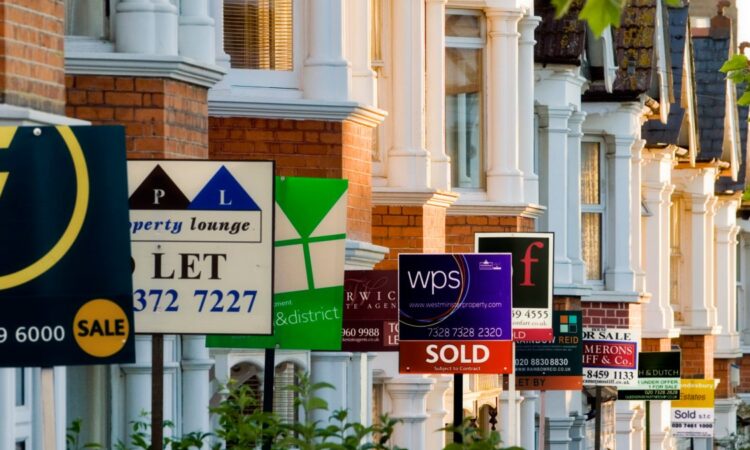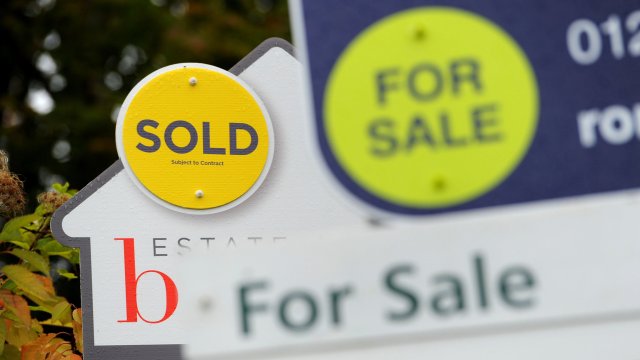
Mortgage rates under 4 per cent are not likely to return to the market this year for most households, experts have said after the Bank of England opted to hold interest rates again.
The best home loan rates on the market were under 4 per cent at the start of the year when the base rate was predicted to fall in March or May, but these sort of offers have since been pulled.
Economists’ forecasts on when interest rates will be lowered vary, although some have suggested June, August, or possibly even later.
These predictions will come as a blow to the Prime Minister Rishi Sunak, who is banking on an improved economy to boost his chances of winning a General Election.
With millions of households being stung with increased mortgage payments because of high interest rates, an August cut would be too late for the Conservatives to benefit as it would give little time for people to feel the impact before an expected autumn election.
The predictions of delays to a cut have prompted a rise in swap rates – the lending rates between banks that have a major impact on the pricing of mortgages – and the lowest available deals now sit above 4.3 per cent.
Even then, these are only available for those with large deposits or equity in their home of 40 per cent or more, known as lower loan-to-value (LTV) customers.
Some experts believe this means mortgage rates could stay high for some time. Aaron Strutt of brokers Trinity Financial said: “We think the recent fixed rate price hikes may well be a blip, but even if the base rate comes down it seems unlikely rates will fall below 4 per cent for quite some time.
The predictions come despite an unexpectedly upbeat hint from the Bank of England that an interest rates cut could come soon. While rates were held for the sixth time in a row at 5.25 per cent on Thursday, Governor Andrew Bailey signaled that interest rate cuts could come as as early as June.
But despite his optimism, mortgage experts warned that there was little prospect of a significant reduction in borrowing costs for homeowners.
“The lowest two-year fixes for borrowers with a 40 per cent deposit now start from 4.77 per cent and five-year fixes from 4.4 per cent,” Mr Strutt added.
“The Bank’s Monetary Policy Committee [which sets the rates] do not seem to be in a rush to lower the base rate. Many homeowners due to remortgage would be pleased if the base rate was brought down to 4.5 per cent by the end of the year. This should in turn mean fixed rates get cheaper.”
Nicholas Mendes, mortgage technical manager at John Charcol, added: “Since the start of the year, the Bank of England has adopted a more conservative approach than initially anticipated by the markets.
“Considering this, by the end of the year I would expect to see a two-year fixed rate in the region of 4.1 to 4.2 per cent, and a five-year fixed rate between 3.7 to 3.9 per cent for lower LTVs. Those with less equity in their homes or with a lower deposit will be marginally below best buys at the moment.”
Tracey Dixon, owner at Pure Mortgage and Protection, said borrowers should not “hold their breath” for mortgages under 4 per cent anytime soon.
“Even the sunniest outlook suggests five-year fixed rates below 4 per cent might not arrive until December, and even then, only for the biggest down payments. The shaky economy could easily delay this further.”
Chris Sykes, technical director and senior mortgage consultant at Private Finance, added that it would be a “fair while” before rates below 4 per cent would be seen.
“Rates usually are above the base rate [which is currently 5.25 per cent], we only have rates under at the moment because of the expected reductions of base and if these expected reductions do not materialise it pushes fixed rates upwards,” he added.
It follows a very different story from this January when three different lenders offered rates below 4 per cent for some customers.
HSBC had a five-year fix at 3.94 per cent for people with 40 per cent deposit or equity, and another at 3.91 per cent with a larger £1,499 fee.
First Direct offered a five-year fix at 3.99 per cent. Generation Home, a small lender aimed at first-time buyers, also had a mortgage of 3.94 per cent which it launched in December.
But rates have slowly crept upwards over the following months, culminating in a flurry of increases in April after March’s inflation figure came in higher than expected.
All the big six mortgage lenders have upped their rates now at least once in the past four weeks.
Mr Mendes said the “turmoil” in the market would likely increase until a cut in the Bank’s interest rate was seen.
“Until we see a bank rate reduction, this will create a void of uncertainty in which markets will continue to speculate and revise their forecasts meaning further periods of continuous repricing from lenders as they adjust profitability against funding lines and market competition,” he said.
An expert panel assembled by i this week predicted that the Bank of England would cut rates in August, followed by two further cuts this year.
But the Bank noted in its monetary policy report on Thursday that there were “upside risks” to inflation, including geopolitical factors in the Middle East, which could push up oil prices.
This could push the timing of any such cuts backwards.
The Government was buoyed by the latest GDP figures, however, which showed the UK economy had come out of recession after growing by 0.6 per cent.
Responding to the GDP figures, Chancellor Jeremy Hunt said: “There is no doubt it has been a difficult few years, but today’s growth figures are proof that the economy is returning to full health for the first time since the pandemic.
“We’re growing this year and have the best outlook among European G7 countries over the next six years, with wages growing faster than inflation, energy prices falling and tax cuts worth £900 to the average worker hitting bank accounts.”
The economy is becoming a key election battleground. Labour’s shadow Home Secretary, Yvette Cooper, told Sky News: “The Government seems to think we should be grateful for the fact that we are no longer in recession and have low growth instead.
“I think this still reflects the fact that working people are still worse off than they were 14 years ago, that people are still paying more on their mortgages, prices are still much higher and actually people are feeling really squeezed.”
Remortgaging soon? Your guide to the best deals
Those remortgaging at the moment will find a lack of deals at the sort of rates seen in January this year.
Below are the cheapest deals available at the moment – once fees are factored in – for someone getting a £300,000 mortgage on a £500,000 home.
The cheapest five-year remortgage deals
- Lloyds Bank – 4.33 per cent with a £999 fee
- NatWest – 4.32 per cent with a £1,495 fee
- Royal Bank of Scotland – 4.42 per cent with a £995 fee.
The cheapest two-year remortgage deals
- First Direct – 4.83 per cent with £490 fee
- First Direct – 5.03 per cent with no fee
- Lloyds Bank – 4.65 per cent with a £999 fee
There are some key things to bear in mind if you’re coming to remortgage now.
- Lock in the best deal now and switch later if you need. If your mortgage deal is due to expire within the next six months, most lenders will allow you to secure a deal now. If a better offer comes along you are then able to switch to that.
David Hollingworth of L&C Mortgages said: “Borrowers that were holding out for lower fixed rates have seen the better rates increase, albeit in relatively small increments. Those that are planning their next remortgage should still decide on a rate as there’s no guarantee of any cuts but if there are improvements they can still review before their current deal comes to an end to take advantage of any lower rates.”
- Do not let you deal expire. If you allow your current deal to expire, your lender will likely move you on to its standard variable rate (SVR). These are very expensive, so you will want to avoid this happening at all costs.
- Moving home? Can you stretch further on your deposit. The cheapest mortgage deals are available to those with what’s known as a low loan-to-value (LTV). This means you own a larger portion of your house via your deposit, and are borrowing against a smaller portion of it. To get your LTV down and access these lower mortgage rates, try and increase your deposit if you can.








